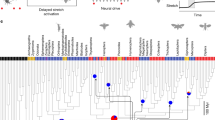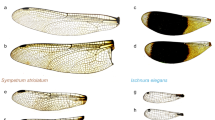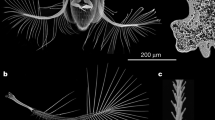Abstract
Small insects usually beat their wings at a higher frequency than large insects. For energetic reasons, the wingbeat frequency is close to the natural resonant frequency of the wing movement1–3. In the flight muscles of many insects, termed fibrillar muscles, the contractions are myogenic: the muscle is only partially activated by calcium; full activation requires mechanical stretch. Demem-branated fibres can be stretch-activated in vitro, allowing both tension changes and the ATPase activity of the fibres to be monitored. The tension response to a sudden length change shows a large delayed tension component (Fig. 1), whose rate-constant determines the frequency at which the muscle can deliver maximum power to the wings. We show here that this rate-constant is roughly proportional to wingbeat frequency in the flying insect. We find that the ATPase rate is slower and is not related to the rate-constant of tension production, and show that insects with widely different wingbeat frequencies have muscles with similar mechanical power output. We conclude: (1) that the rate-limiting step in the cross-bridge cycle, which limits the ATPase activity, follows the state in which maximum active tension is produced and does not limit the rate at which tension is generated; (2) that the first tension-generating state is probably an actomyosin.ADP.Pi state; and (3) that a preceding step, probably an actomyosin.ADP.Pi isomeriz-ation, which controls the rate-constant for force generation, is faster in smaller insects than in larger ones.
This is a preview of subscription content, access via your institution
Access options
Subscribe to this journal
Receive 51 print issues and online access
$199.00 per year
only $3.90 per issue
Buy this article
- Purchase on Springer Link
- Instant access to full article PDF
Prices may be subject to local taxes which are calculated during checkout
Similar content being viewed by others
Author information
Authors and Affiliations
Rights and permissions
About this article
Cite this article
Molloy, J., Kyrtatas, V., Sparrow, J. et al. Kinetics of flight muscles from insects with different wingbeat frequencies. Nature 328, 449–451 (1987). https://doi.org/10.1038/328449a0
Received:
Accepted:
Issue Date:
DOI: https://doi.org/10.1038/328449a0
This article is cited by
-
Bridging two insect flight modes in evolution, physiology and robophysics
Nature (2023)
-
Effects of Biotic and Abiotic Factors on Flight Performance of Ostrinia furnacalis
Journal of Insect Behavior (2021)
-
The structural role of high molecular weight tropomyosins in dipteran indirect flight muscle and the effect of phosphorylation
Journal of Muscle Research and Cell Motility (2006)
-
The myosin converter domain modulates muscle performance
Nature Cell Biology (2002)
-
The motor protein myosin-I produces its working stroke in two steps
Nature (1999)
Comments
By submitting a comment you agree to abide by our Terms and Community Guidelines. If you find something abusive or that does not comply with our terms or guidelines please flag it as inappropriate.



